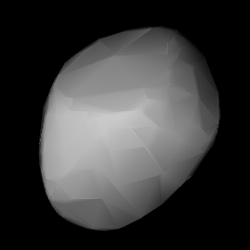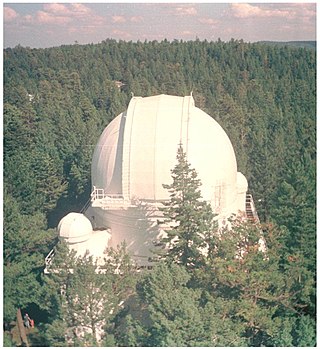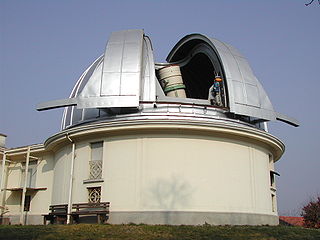
The Apache Point Observatory is an astronomical observatory located in the Sacramento Mountains in Sunspot, New Mexico, United States, approximately 18 miles (29 km) south of Cloudcroft. The observatory is operated by New Mexico State University (NMSU) and owned by the Astrophysical Research Consortium (ARC). Access to the telescopes and buildings is private and restricted.

The Asiago-DLR Asteroid Survey was an astronomical survey conducted in the early 2000s to search for comets and asteroids, with special emphasis on near-Earth objects. The Minor Planet Center directly credits ADAS with the discovery of more than 200 minor planets after 2001.
Farpoint Observatory is an astronomical observatory owned and operated by the Northeast Kansas Amateur Astronomers' League, or NEKAAL. It is located on the grounds of Mission Valley High School at Eskridge, near Auburn, Kansas, approximately 30 miles (48 km) southwest of Topeka, Kansas, United States.

The Arcetri Observatory is an astrophysical observatory located in the hilly area of Arcetri on the outskirts of Florence, Italy. It is located close to Villa Il Gioiello, the residence of Galileo Galilei from 1631 to 1642.
Anderson Mesa Station is an astronomical observatory established in 1959 as a dark-sky observing site for Lowell Observatory. It is located at Anderson Mesa in Coconino County, Arizona, about 12 miles (19 km) southeast of Lowell's main campus on Mars Hill in Flagstaff, Arizona.

The V. P. Engel'gardt Astronomical Observatory, also known simply as the Engelhardt Observatory, is located 20 kilometers west of Kazan, Russia. Its observatory code is 136. The co-ordinates are about 55°50′23″N48°48′45″E.

The Pistoia Mountains Astronomical Observatory, also known as the San Marcello Observatory and the Pian dei Termini Observatory, is an astronomical observatory in San Marcello Piteglio, Tuscany, central Italy.
1031 Arctica, provisional designation 1924 RR, is a dark asteroid from the outer region of the asteroid belt, approximately 75 kilometers in diameter. It was discovered on 6 June 1924, by Soviet−Russian astronomer Sergey Belyavsky at Simeiz Observatory on the Crimean peninsula. It was named for the Arctic Sea.

1107 Lictoria is a large Hygiea asteroid, approximately 79 kilometers in diameter, from the outer regions of the asteroid belt. It was discovered by Luigi Volta at the Pino Torinese Observatory in 1929, and named after the Fasces Lictores, Latin for "Fasci Littori", the symbol of the Italian fascist party.
1868 Thersites is a large Jupiter trojan from the Greek camp, approximately 70 kilometers in diameter. Discovered during the Palomar–Leiden survey at Palomar in 1960, it was later named after the warrior Thersites from Greek mythology. The presumed carbonaceous C-type asteroid belongs to the 50 largest Jupiter trojans and has a rotation period of 10.48 hours.
4722 Agelaos is a Jupiter trojan from the Trojan camp, approximately 53 kilometers in diameter. It was discovered during the third Palomar–Leiden Trojan survey at the Palomar Observatory in California in 1977. The Jovian asteroid has a rotation period of 18.4 hours and belongs to the 90 largest Jupiter trojans. It was named after Agelaus from Greek mythology.
2895 Memnon is a dark Jupiter trojan from the Trojan camp, approximately 56 kilometers in diameter. It was discovered on 10 January 1981, by American astronomer Norman Thomas at Lowell's Anderson Mesa Station near Flagstaff, Arizona, in the United States. The assumed C-type asteroid has a rotation period of 7.5 hours and belongs to the 80 largest Jupiter trojans. It was named after King Memnon from Greek mythology.
7794 Sanvito, provisional designation 1996 AD4, is a bright Vestian asteroid from the inner regions of the asteroid belt, approximately 4.6 kilometers (2.9 miles) in diameter. It was discovered on 15 January 1996, by Italian astronomers Ulisse Munari and Maura Tombelli at the Cima Ekar Observing Station in Tuscany, Italy. The likely V-type asteroid was named after Italian amateur astronomer Roberto di San Vito.
1608 Muñoz, provisional designation 1951 RZ, is a Flora asteroid from the inner regions of the asteroid belt, approximately 6.5 kilometers in diameter. It was discovered on 1 September 1951, by Argentine astronomer Miguel Itzigsohn at the La Plata Astronomical Observatory, in La Plata, Argentina. The S-type asteroid has a rotation period of 5.3 hours. It was named after F. A. Muñoz, one of the assistant astronomers at the discovering observatory.

NASA Orbital Debris Observatory (NODO) was an astronomical observatory located in the Lincoln National Forest near Cloudcroft, New Mexico approximately 23 kilometers (14 mi) northeast of Alamogordo. From 1995 to 2002 it hosted two telescopes funded and operated by NASA that were dedicated to detecting orbital debris. The facility was initially called the Cloudcroft Electro-Optical Research Facility when it was completed in 1962, and was also known as the Cloudcroft Observatory. It is now privately owned by Embry-Riddle University.

The Cima Ekar Observing Station is an astronomical observatory on the crest of Cima Ekar, a mountain ridge located approximately 4 kilometers southeast of and 350 m higher than the town of Asiago, Italy.

Merate Astronomical Observatory is an old observatory in Merate (Lecco), Italy. It has housed a 1-meter Zeiss telescope since 1926.

The Argentine National Observatory, today the Astronomical Observatory of Córdoba, was founded on 24 October 1871, by Argentine president Domingo F. Sarmiento and the North American astronomer Benjamin Apthorp Gould.

The Tien Shan Astronomical Observatory is an astronomical observatory located in the Tien Shan Mountains at 2,800 meters altitude, 30 kilometers south of the city of Almaty in Kazakhstan. It was assigned to the Sternberg Astronomical Institute (GAISh) until the collapse of the Soviet Union. The observatory is a state-owned scientific institution that belongs to the Astrophysical Institute after V.G. Fesenkov. It is often used for photometric investigations of variable stars in the Milky Way, eclipsing systems.

La Specola is a 14th-century tower, formerly part of a medieval castle, and converted in 1767 into an astronomical observatory (specula) in Padua, region of Veneto, Italy.












